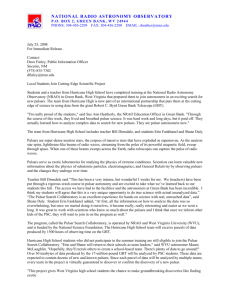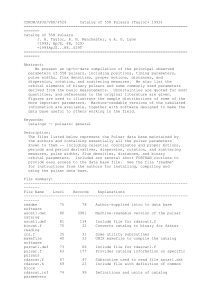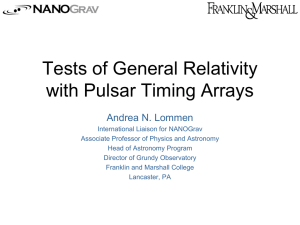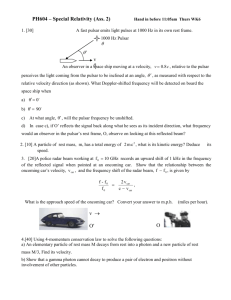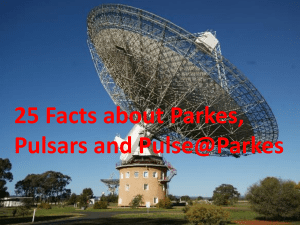PPT
advertisement
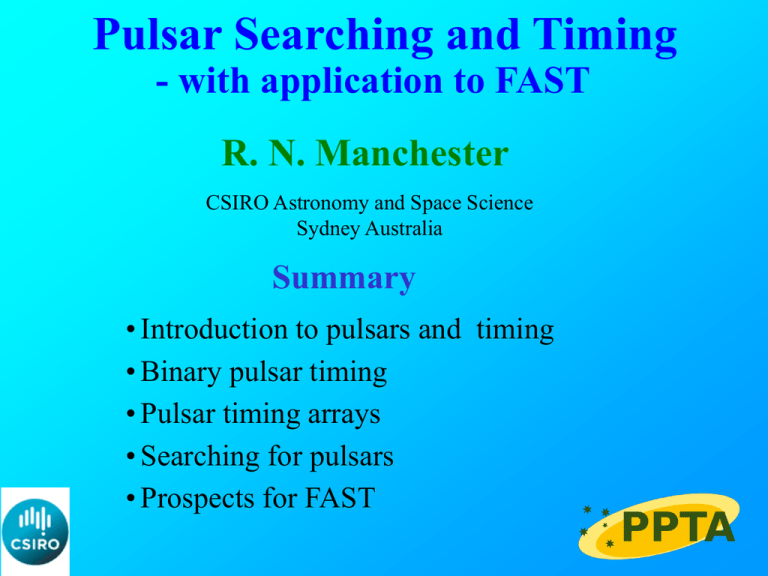
Pulsar Searching and Timing - with application to FAST R. N. Manchester CSIRO Astronomy and Space Science Sydney Australia Summary • Introduction to pulsars and timing • Binary pulsar timing • Pulsar timing arrays • Searching for pulsars • Prospects for FAST Spin-Powered Pulsars: A Census • Currently 2008 known (published) pulsars • 1846 rotation-powered disk pulsars • 186 in binary systems • 252 millisecond pulsars • 141 in globular clusters • 8 X-ray isolated neutron stars • 16 AXP/SGR • 20 extra-galactic pulsars Data from ATNF Pulsar Catalogue, V1.44 (www.atnf.csiro.au/research/pulsar/psrcat) (Manchester et al. 2005) Pulsar Origins Pulsars are believed to be rotating neutron stars – two main classes: Normal Pulsars: • Formed in supernovae • Periods between 0.03 and 10 s • Relatively young (< 107 years) • Mostly single (non-binary) (ESO – VLT) Millisecond Pulsars (MSPs): • MSPs are very old (~109 years). • Mostly binary • They have been ‘recycled’ by accretion from an evolving binary companion. • This accretion spins up the neutron star up to millisecond periods • During the accretion phase the system may be detectable as an X-ray binary system. Pulsars as Clocks • Neutron stars are tiny (about 25 km across) but have a mass of about 1.4 times that of the Sun • They are incredibly dense and have gravity 1012 times as strong as that of the Earth • Because of this large mass and small radius, their spin rates and hence pulsar periods – are very stable e.g., on February 4, 2008, PSR J0437-4715 had a period of : 5.757451936712629 0.000000000000001 ms • Although pulsar periods are very stable, they are not constant. Pulsars lose energy and slow down • Typical slowdown rates are less than a microsecond per year Measurement of pulsar periods • Add many pulses to form a mean pulse profile • Cross-correlate observed mean profile with a standard template to give the pulse time-of-arrival (ToA) • Measure a series of ToAs over days – weeks – months – years • Transfer ToAs to an inertial frame - the Solar System barycentre • Compare barycentric ToAs with predicted values from a model for pulsar – the differences are called timing residuals. • Fit the observed residuals with functions representing errors in the model parameters (pulsar position, period, binary period etc.) • Gives improved parameters: dP ~ rms residual/data span • Remaining residuals may be noise – or may be science! . The P – P Diagram P = Pulsar period . P = dP/dt = slow-down rate • Pulsars are diverse with several different classes . • Most pulsars have P ~ 10-15 . • MSPs have P smaller by about 5 orders of magnitude • Most MSPs are binary, but few normal pulsars are . • tc = P/(2P) is an indicator of pulsar age (and lifetime) • Surface . 1/2 dipole magnetic field ~ (PP) MSPs have lifetimes of ~1010 years! Galactic Disk pulsars Sources of Pulsar Timing “Noise” Intrinsic noise • Period fluctuations, glitches • Pulse shape changes Perturbations of the pulsar’s motion • Gravitational wave background • Globular cluster accelerations • Orbital perturbations – planets, 1st order Doppler, relativistic effects Propagation effects • Wind from binary companion • Variations in interstellar dispersion • Scintillation effects Perturbations of the Earth’s motion • Gravitational wave background • Errors in the Solar-system ephemeris Clock errors • Timescale errors • Errors in time transfer Instrumental errors • Radio-frequency interference and receiver non-linearities • Digitisation artifacts or errors • Calibration errors and signal processing artifacts and errors Receiver noise PSR B1913+16: The First Binary Pulsar Discovered at Arecibo Observatory by Russell Hulse & Joe Taylor in 1975 Pulsar period 59 ms, a recycled pulsar Doppler shift in observed period due to orbital motion Orbital period only 7 hr 45 min Maximum orbital velocity 0.1% of velocity of light Relativistic effects detectable! Post-Keplerian Parameters: PSR B1913+16 Given the Keplerian orbital parameters and assuming general relativity: • Periastron advance: 4.226607(7) deg/year M = mp + mc • Gravitational redshift + Transverse Doppler: 4.294(1) ms mc(mp + 2mc)M-4/3 • Orbital period decay: -2.4211(14) x 10-12 mp mc M-1/3 First two measurements determine mp and mc. Third measurement checks consistency with adopted theory. Mp = 1.4408 0.0003 Msun Mc = 1.3873 0.0003 Msun Both neutron stars! (Weisberg & Taylor 2005) Orbital Decay in PSR B1913+16 • Rapid orbital motion of two stars in PSR B1913+16 generates gravitational waves PSR B1913+16 Orbit Decay • Energy loss causes slow decrease of orbital period • Can predict rate of orbit decay from known orbital parameters and masses of the two stars using general relativity • Ratio of measured value to predicted value = 1.0013 0.0021 Confirmation of general relativity! First observational evidence for gravitational waves! (Weisberg & Taylor 2005) PSR J0730-3039A/B The first double pulsar! Discovered at Parkes in 2003 One of top ten science breakthroughs of 2004 - Science PA = 22 ms, PB = 2.7 s Orbital period 2.4 hours! Periastron advance 16.9 deg/yr! (Burgay et al., 2003; Lyne et al. 2004) Highly relativistic binary system! Measured Post-Keplerian Parameters for PSR J0737-3039A/B GR value Measured value . Periast. adv. (deg/yr) . Grav. Redshift (ms) Pb Orbit decay r Shapiro range (s) s Shapiro sin i 0.3842 16.8995 0.0007 0.386 0.003 Improves as T1.5 T1.5 -1.248 x 10-12 (-1.252 0.017) x 10-12 T2.5 6.15 0.99987 6.2 0.3 0.99974 +16 -39 T0.5 T0.5 GR is OK! Consistent at the 0.05% level! Non-radiative test - distinct from PSR B1913+16 (Kramer et al. 2006) The Double Pulsar: Update • PSR J0737-3039B has disappeared! • Beam has moved away due to orbital precession • Expected to return in 5 – 10 years • Continued timing at Parkes and GBT has refined relativistic parameters • Now limits deviations from GR to 0.02% (Kramer et al. 2012) PSR J1614-2230 • Binary millisecond pulsar discovered in GBT search of unidentified Fermi gamma-ray sources • Pulsar period ~ 3.15 ms, characteristic age ~5.2 Gyr • Almost circular orbit, binary period ~ 8.68 days • Timed at GBT with dense observations over one orbit • Clear Shapiro delay detection: Orbit inclination = 89.17(2) deg.! Companion mass = 0.500(6) Msun Pulsar mass =1.97(4) Msun!! • Large pulsar mass can’t be attributed to accretion Neutron star born massive (Demorest et al. 2010) PSR J1614-2230 Shapiro Delay a) Shapiro delay signature b) Timing residuals after fitting for all pulsar parameters except Shapiro delay c) Final timing residuals Orbital Phase (Demorest et al. 2010) Mass-Radius Diagram for Neutron Stars Pulsar Timing Arrays (PTAs) • A PTA consists of many pulsars widely distributed on the sky with frequent high-precision timing observations over a long data span • Aims to detect signals which are correlated between different pulsars • Only millisecond pulsars can be timed with sufficient precision and have sufficiently stable periods to reach main objectives • PTAs can detect a stochastic gravitational-wave background requires observations of ~20 MSPs over 5 – 10 years – could be first direct detection of gravitational waves (GWs)! • PTAs can detect instabilities in terrestrial time standards and establish a pulsar timescale • PTAs can improve our knowledge of Solar System properties, e.g. masses and orbits of outer planets and asteroids Idea first discussed by Hellings & Downs (1983), Romani (1989) and Foster & Backer (1990) Detecting a Stochastic GW Background • Super-massive black-hole binary (SMBHB) systems in the cores of distant galaxies (formed through galaxy mergers) will generate a stochastic background of GWs in the Galaxy • GWs passing over the pulsars will generate an uncorrelated signal • GWs passing over the Earth will generate a correlated signal • For an isotropic stochastic background, the correlation in Hellings & Downs correlation function the timing residuals for pulsar pairs is dependent only on the angle between the pulsars • Anti-correlation for angles ~90o because of quadrupolar nature of GWs TEMPO2 simulation for the PPTA data set (Hobbs et al. 2009) Major Pulsar Timing Array Projects European Pulsar Timing Array (EPTA) • Radio telescopes at Westerbork, Effelsberg, Nancay, Jodrell Bank, (Cagliari) • Currently used separately, but plan to combine for more sensitivity • High-quality data (rms residual < 2.5 s) for 9 millisecond pulsars North American pulsar timing array (NANOGrav) • Data from Arecibo and Green Bank Telescope • High-quality data for 17 millisecond pulsars Parkes Pulsar Timing Array (PPTA) • Data from Parkes 64m radio telescope in Australia • High-quality data for 20 millisecond pulsars Agreement on combining data sets to form the International Pulsar Timing Array (IPTA) The PPTA Pulsars All (published) MSPs not in globular clusters PPTA Three-band Timing Residuals 50cm 10cm 20cm PPTA Limit for Stochastic GW Background Range of predictions by Sesana et al. (2008) (1 yr)-1 (Shannon et al. 2012) A Pulsar Timescale: TT(PPTA11) • Terrestrial time, TT(TAI), defined by a weighted average of cesium clocks at time centres around the world • Revisions of TT(TAI) published each year by BIPM: TT(BIPMxx) • Any irregularities in the reference timescale used for a PTA will produce identical residual variations in all psrs • PPTA extended data set used with TT(TAI) as TT(BIPM11) – TT(TAI) reference • Reproduces known irregularities in TT(TAI) and defines a pulsar timescale TT(PPTA11) (Hobbs et al. 2012) PRESTO Output Page Searching for Pulsars Frequency • Most pulsars have been found in searches at radio frequencies • Pulsars have two main properties that are used to distinguish them from (most) other radio signals: periodicity and dispersion • Multi-channel data sampled Time typically at ~100 s intervals • Data summed in frequency with a range of dispersive delays and (sometimes) accelerations and then Fourier transformed • Searched in modulation frequency with harmonic summing • Candidates plotted and selected for confirmation • Observed again at same position to confirm periodicity and dispersion (www.cv.nrao.edu/~sransom/presto/) Parkes Multibeam Pulsar Survey • Covers strip along Galactic plane, -100o < l < 50o, |b| < 5o • Uses 13-beam 20cm Multibeam receiver on the Parkes 64-m telescope • Central frequency 1374 MHz, bandwidth 288 MHz, 96 channels/poln/beam • Sampling interval 250 s, time/pointing 35 min, 3080 pointings • Survey observations commenced 1997, completed 2003 • Processed on work-station clusters at ATNF, JBO and McGill • 785 pulsars discovered, 1065 detected • At least 18 months of timing data obtained for each pulsar Principal papers: I: Manchester et al., MNRAS, 328, 17 (2001) System and survey description, 100 pulsars II: Morris et al., MNRAS, 335, 275 (2002) 120 pulsars, preliminary population statistics III: Kramer et al., MNRAS, 342, 1299 (2003) 200 pulsars, young pulsars and -ray sources IV: Hobbs et al., MNRAS, 352, 1439 (2004) 180 pulsars, 281 previously known pulsars V: Faulkner et al., MNRAS, 355, 147 (2004) Reprocessing methods, 17 binary/MSPs VI: Lorimer et al., MNRAS, 372, 777 (2006) 142 pulsars, Galactic population and evolution Other Recent Surveys • PALFA Survey (Cordes et al. 2006) 7-beam feed on Arecibo, ~1400 MHz 21 pulsars discovered so far • Fermi Radio IDs (Hessels et al. 2011, Kerr et al. 2012) Various radio telescopes ~20 discoveries, mostly MSPs • Fermi Blind searches (Pletsch et al. 2012) Search for periodicities in gamma-ray data 33 discoveries, mostly young pulsars • HTRU survey (Keith et al. 2010) Parkes MB receiver with digital backend system 33 pulsars so far Galactic Distribution of Pulsars Prospects for FAST • FAST effective diameter ~300 m • Telescope Gain ~ 16 K/Jy • Maximum zenith angle 40o – 60o • 0.07 – 3.0 GHz in several bands • 19-beam 20cm receiver, Tsys ~ 20K • Bandwidth ~ 400 MHz For FAST, in 1 min, Srms ~ 7 Jy (for Parkes MB, Srms ~ 260 Jy) Limiting flux density for detection: st is S/N threshold w is pulse duty cycle For search detection need st ~ 8; for most timing st ~10, for PTAs > 100 Pulsar Surveys with FAST • FAST zenith angle limit initially 40o • Can see Galactic plane from l ~ 20o to l ~ 230o • Use 19-beam 20cm receiver, HPBW ~3.4 arc min • With tobs = 600 s, Smin ~ 17 Jy (PMPS: Smin ~200 Jy) • Tessellate sky with sets of four pointings covering ~0.25 sq deg • Can mesh sets to cover whole sky Simulation of FAST Pulsar Surveys (Smits et al. 2009) FAST “All-sky” Pulsar Survey (ZA < 40o) • 4500 “normal” pulsars detected (incl. ~1000 known) • 500 MSPs detected (incl. ~120 known) • Total time for survey ~300 8-hour days (Smits et al. 2009) Pulsar Timing with FAST • Need wide bandwidth single-beam receiver, e.g., 0.5 – 3 GHz system similar to MPI/CASS receiver Too few pulsars to use MB receiver Need wide b/w for sensitivity and dispersion correction • For “normal” pulsars, need 1 – 2 min per pulsar – slew rate important! • For PTA timing, need 10 – 30 min per pulsar Huge benefit to PTA studies from larger sample of pulsars Sensitivity of a PTA to a Stochastic Gravitational-wave Background Black: 20 psrs Red: 50 psrs Blue: 200 psrs Plain line: 5 yrs Line with ×: 10 yrs Line with o: 20 yrs (Sesana prediction) (Manchester et al. 2012) With FAST discoveries, expect ~200 MSPs with S1400 >0.3 mJy Effect of Pulse Jitter • When S/N of an individual pulse is ~1, ToA precision is limited by pulse-to-pulse fluctuations • For FAST this will occur for normal pulsars with S1400 > 0.1 mJy and MSPs with S1400 > 1 mJy (Cordes & Shannon 2010) Summary •Pulsars are an incredibly interesting phenomenon •FAST will be an extremely powerful telescope for pulsar studies • FAST will have same effective area as the central 1 km of SKA and the huge advantage of a filled aperture •Pulsar searches will discover ~3000 normal pulsars and ~350 MSPs •FAST can time ~700 normal pulsars/day and ~100 pulsars/day to PTA precision 谢谢 Thank you! Clock errors All pulsars have the same TOA variations: monopole signature Solar-System ephemeris errors Dipole signature Gravitational waves Quadrupole signature Can separate these effects provided there is a sufficient number of widely distributed pulsars The Parkes Pulsar Timing Array Collaboration CSIRO Astronomy and Space Science, Sydney Dick Manchester, George Hobbs, Ryan Shannon, Mike Keith, Sarah Burke-Spolaor, Aidan Hotan, John Sarkissian, John Reynolds, Mike Kesteven, Warwick Wilson, Grant Hampson, Andrew Brown, Ankur Chaudhary, (Russell Edwards), (Jonathan Khoo), (Daniel Yardley) Swinburne University of Technology, Melbourne Matthew Bailes, Willem van Straten, Stefan Oslowski, Andrew Jameson, (Ramesh Bhat), (Jonathon Kocz) Monash University, Melbourne Yuri Levin University of Melbourne Vikram Ravi (Stuart Wyithe) University of California, San Diego Bill Coles University of Texas, Brownsville (Rick Jenet) MPIfR, Bonn (David Champion), (Joris Verbiest), (KJ Lee) Southwest University, Chongqing Xiaopeng You Xinjiang Astronomical Observatory, Urumqi (Wenming Yan), Jingbo Wang National Space Science Center, Beijing Xinping Deng DM Variations Extended PPTA Data Sets • Parkes data from Swinburne timing program for 1994 – 2006 (Verbiest et al. 2008, 2009) added to PPTA three-band data sets • Extended data sets cover up to 17 years • Most instrumental offsets measured from overlapping data and fixed • DM offsets included and held fixed • Fit with Cholesky algorithm to pulsar parameters and remaining instrumental offsets • Fit to just F0, F1 for best-band data; all other parameters fixed Current Limits on GW Background Characteristic strain spectrum: For a stochastic background from binary SMBBH, a = -2/3 EPTA: 7 MSPs, 10 yrs, A < 6 x 10-15 (van Haasteren et al. 2011) NANOGrav: 17 MSPs, 5.5 yrs, A < 7.2 x 10-15 (Demorest et al 2012) PPTA: 19 MSPs, up to 17 yrs, A < 2.4 x 10-15 (Shannon et al 2012) New method, better data sets Single Sources • Likely that many SMBH binary systems are highly eccentric • GW spectrum may be dominated by a strong individual source First GW detection by PTAs could be a single source with period <~ 1 year! (Sesana 2012) The International Pulsar Timing Array • The IPTA is a consortium of consortia, namely existing PTAs from around the world • Currently three members: EPTA, NANOGrav and PPTA • The aims of the IPTA are to facilitate collaboration between participating PTA groups and to promote progress toward PTA scientific goals • There is a Steering Committee which sets policy guidelines for data sharing, publication of results etc. • The IPTA organises annual Student Workshops and Science Meetings – 2013 meetings will be in Krabi, Thailand, June 17-28 • The IPTA would welcome approaches from new timing consortia See: www.ipta4gw.org Detection of Gravitational Waves • Prediction of general relativity and other theories of gravity • Generated by acceleration of massive object(s) • Astrophysical sources: Inflation era fluctuations Cosmic strings BH formation in early Universe Binary black holes in galaxies Coalescing neutron-star binaries Compact X-ray binaries (K. Thorne, T. Carnahan, LISA Gallery) The PPTA Project • Using the Parkes 64-m radio telescope in three bands, 50cm (700 MHz), 20cm (1400 MHz) and 10cm (3100 MHz) to observe 21 MSPs • Observations at 2 - 3 week intervals • Regular good-quality observations since 2005 March • Digital filterbanks and baseband recording systems used • Database and processing pipeline – PSRCHIVE and TEMPO2 • Studying limit and detection algorithms for different types of GW sources • Simulating GW signals and studying implications for galaxy evolution models • Establishing a pulsar-based timescale and investigating Solar system properties • Using PPTA data sets to investigate individual pulsar properties, e.g., pulse polarisation, binary evolution, astrometry etc. Website: www.atnf.csiro.au/research/pulsar/ppta PPTA “Best” Data Sets • 6-year data span • Lowest rms residuals for: J0437-4715 – 75 ns J1909-3744 – 133 ns (both at 10cm) • Significant “red” noise • “White” rms residuals: J0437-4715 – 46 ns J1909-3744 – 61 ns The Second Molonglo Survey 1978 155 pulsars: more than doubled the number known Parkes 70cm southern survey 1991-1996 101 pulsars 17 MSPs Tests of Gravitational Theories • PSR B1913+16, discovered at Arecibo by Russell Hulse & Joe Taylor in 1975 • First-known binary pulsar, orb. period 7.75 h • Double-neutron-star system – relativistic orbit perturbations detectable First accurate measurement of n-star mass First observational evidence for gravitational waves Confirmation of general relativity as an accurate theory of gravity Nobel Prize for Hulse and Taylor in 1993! (Weiserg & Taylor 2005) PSR J0737-3039A/B Post-Keplerian Effects R: Mass ratio . : periastron advance : gravitational redshift r & s: Shapiro delay . Pb: orbit decay • Six measured parameters • Four independent tests • Fully consistent with general relativity (0.05%) (Kramer et al. 2006) DM Variations and Correction • DM offsets solved for along with pulsar parameters and frequency-independent (“common-mode”) signal using Cholesky algorithm in Tempo2 on PPTA three-band data sets • DM offsets measured at intervals through data sets with linear interpolation between values • Interval size taken to be inverse of modulation frequency where red (DM) signal is same power as white noise • Mean DM offset constrained to be zero • Effectiveness of algorithm tested using simulations (Keith et al. 2012) New Instruments MEERKAT – SKA 1 (Sth Africa) • 250 x 15m dishes, single pixel feeds • 3 bands: 0.5 – 3.0 GHz • Collecting area ~ Arecibo • Complete ~2019 • Good for pulsar timing ASKAP – SKA 1 (Australia) • 100 x 15m dishes, PAFs – 100 beams over 30 sq. degrees • 0.7 – 1.7 GHz • ~50% area within 1 km core • Good for searches and timing of “normal” pulsars More Distant Future Square Kilometer Array – Phase 2 • Mid-frequency array in South Africa • 3000 x 15m dishes • Area ~5 x FAST • But ~20% within 1 km • With PAFs – fantastic survey instrument, speed ~25 x FAST • But computing requirements horrendous: 100’s GB/s, 100 TB RAM • Can’t store raw data: ~10 petaflop computing to process in real time • Complete 2023+ • Could discover 20,000 pulsars, 5000 MSPs (J Cordes) The Gravitational Wave Spectrum
